|
|
Welcome to the Winter/Spring 2020 edition of the Hung Liu Studio Newsletter (#23). Please enjoy looking through it! Also, check out Hung's website.
|
|
|
Happy Year of the Rat!!!
2020
|

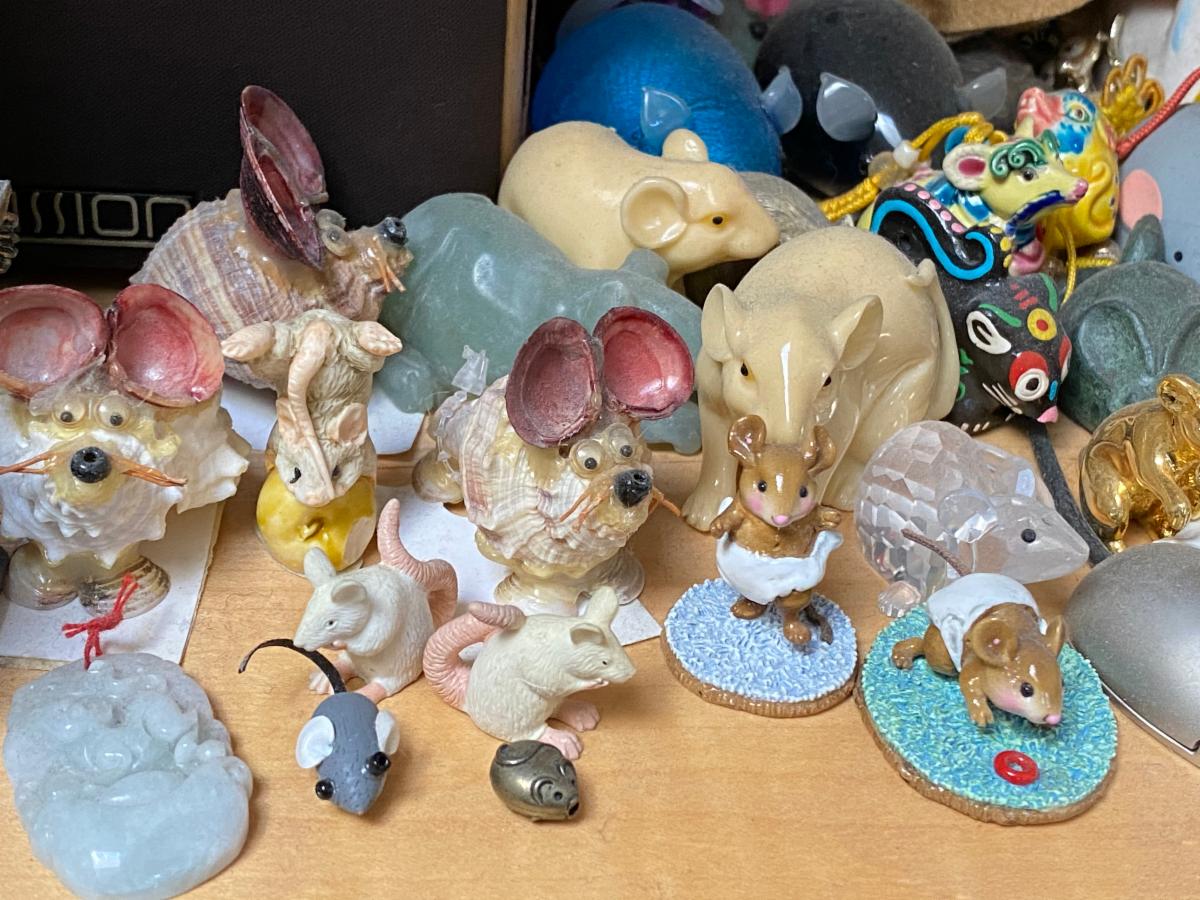
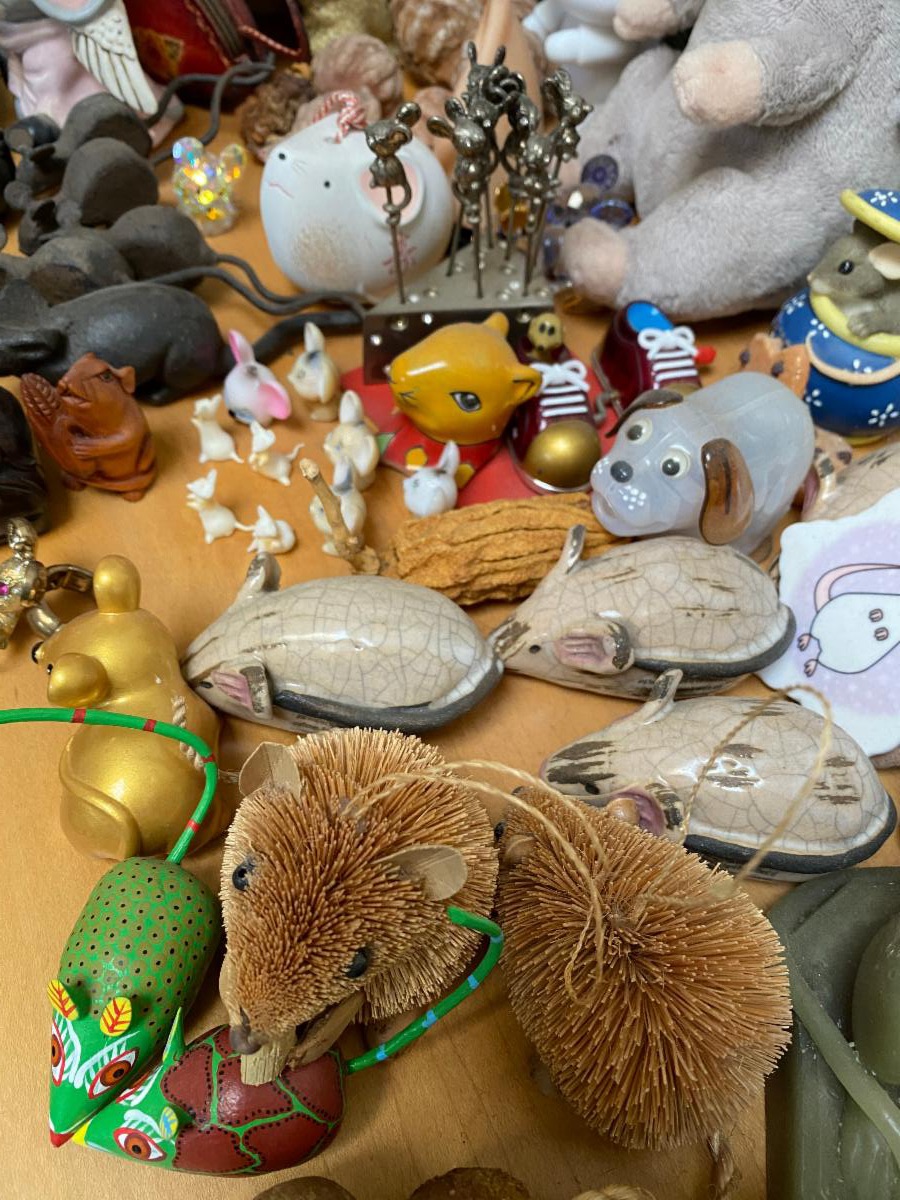
This is Hung's year - born in the Year of the Rat, 1948. Every twelve years our animals circle back, and each time they do, something important happens. The pictures above are from the artist's rat collection. Next time: 2032 ...
|
Hung Liu: This Land...
Nancy Hoffman Gallery
New York
Oct 24 - Dec 7, 2019

In "This Land ...," Hung continued her focus on Lang's subjects as they migrate across America in the 1930s in search of work, dignity, and salvation. Though it invokes the title of Woody Guthrie's anthem of 1940, written as a rejoinder to Irving Berlin's "America the Beautiful," the title of Liu's exhibition, "This Land ...," does not offer the visions of sweeping vistas - the ribbons of highway, the golden valleys, the diamond deserts, or the wheat fields waving - but a landscape of broken down cars, flattened tires, stranded and damaged and hollow people, tarpaulin and cardboard shacks, a harvest of bitter onions. "This Land ...," like the ellipsis in the title, indicates an omission, all that "America the beautiful" was not.
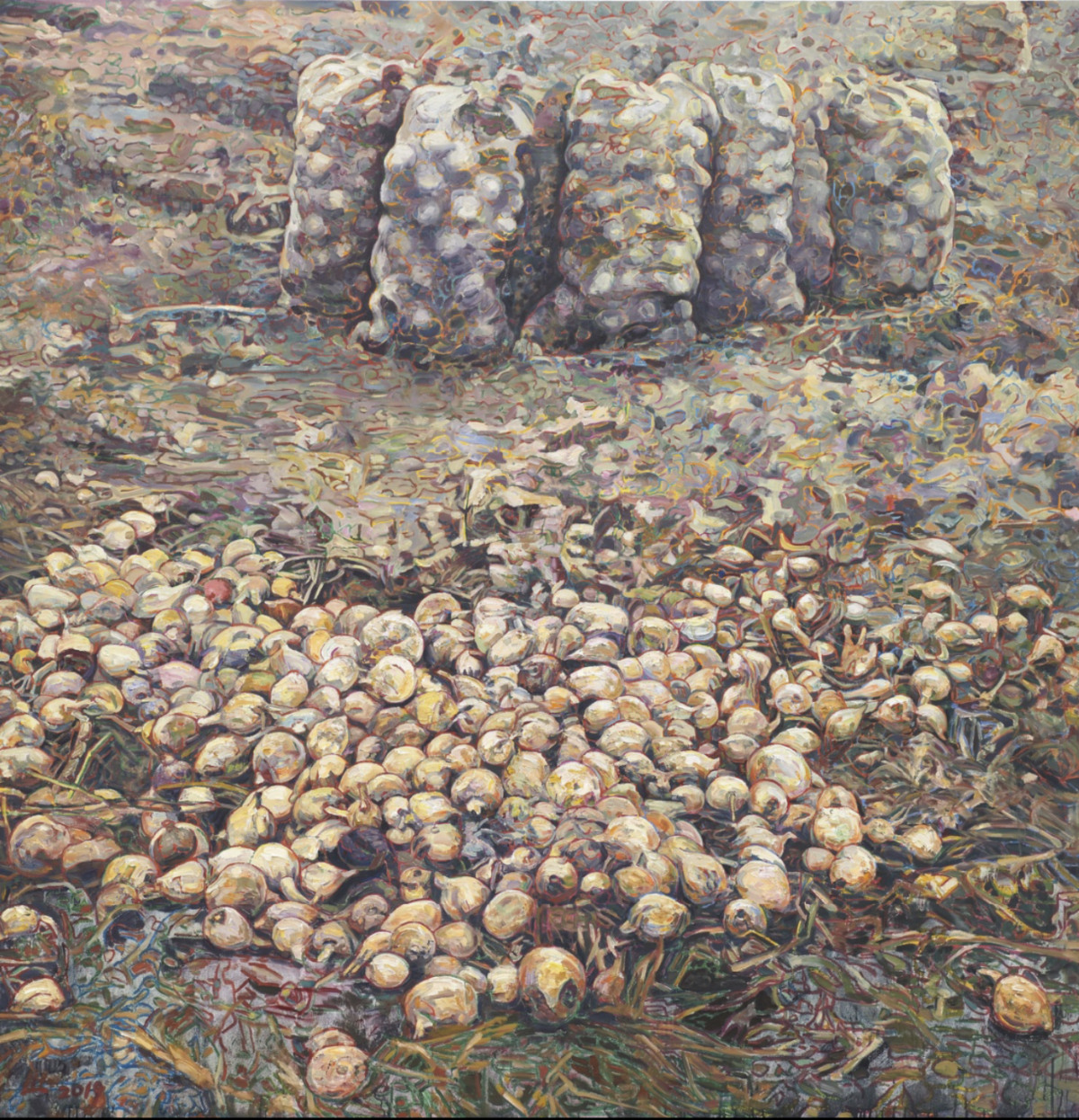
Liu's painting style, with its fluid washes, expressionistic brushstrokes, and eroding photo-based images, has often been thought of as a kind of weeping realism - especially when applied to Chinese subjects. Reacting against the rigid techniques of Chinese Socialist Realism, in which she was trained, Liu's hand has deftly engaged her subjects, turning old photographs into new paintings, and anonymous figures into dignified individuals. For her Lange-inspired works, Liu has developed a kind of topographic painting technique in which she "maps" an image with colored lines, the richness of which belies the real-world poverty of her subjects. What emerges is a kind of vascular web of color that holds the images, especially those of people, more firmly in place. Liu thinks of these webs as cracks of light breaking through, an homage, perhaps, to Lange, who was working to change the plight of the migrants she photographed.
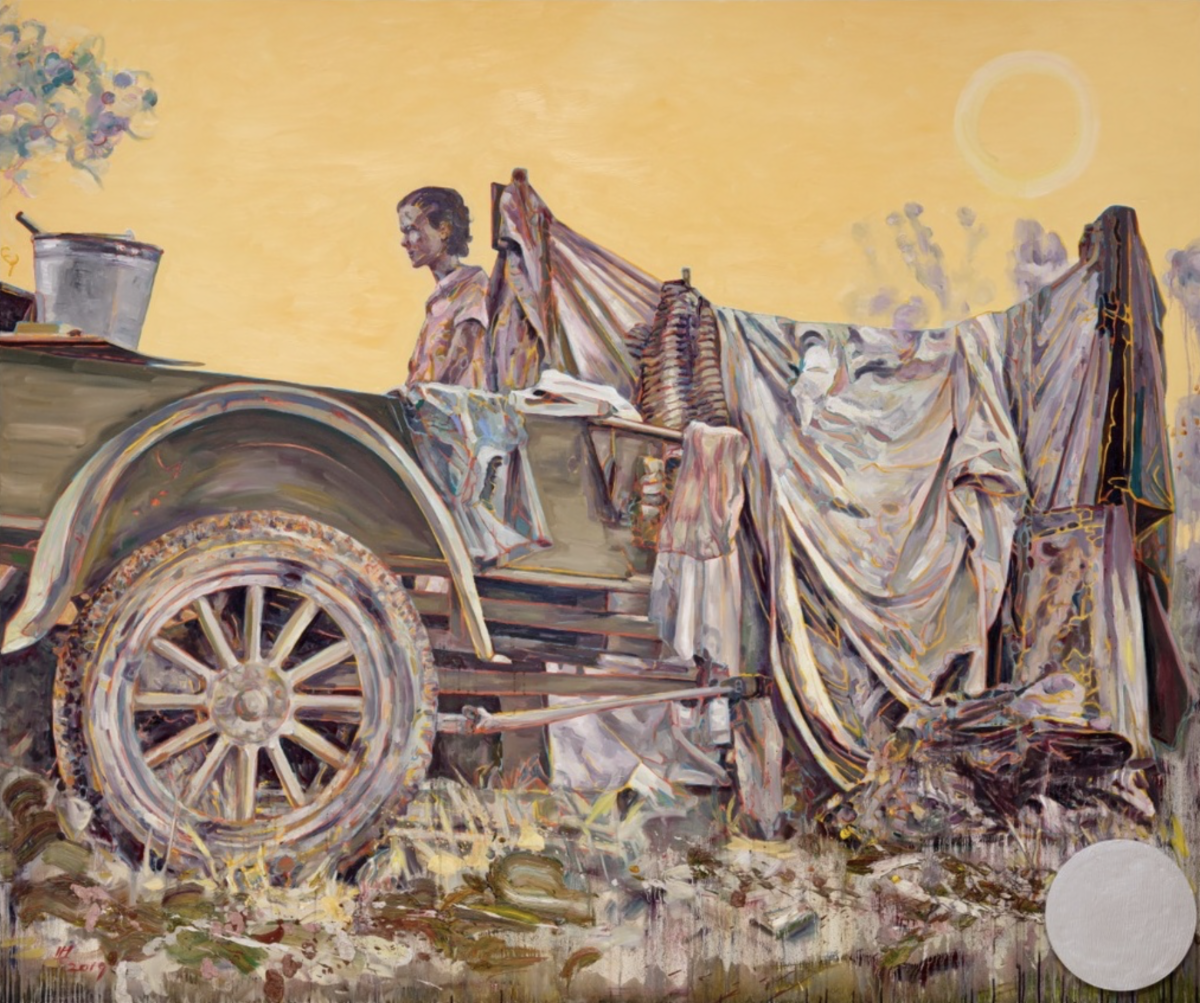
While the larger new paintings confidently combine Liu's traditional weeping realism and her more recent topographic mapping, the smaller ones - the "Duster Shack" series - are richly expressionistic improvisations that seem bigger than they are. Also taken from Lange's photographs, they depict ramshackle shelters cobbled together by migrants who have nowhere to lie down except where they happen to find themselves at day's - or road's - end. The mineral mix of the paint and colors are almost analogues for the mix of materials - boards, blankets, old tires, even cars - that compose them. The term "Duster" refers here to refugees from the Dust Bowl.
The human figures depicted in the larger painting are mostly studies in dejection, with several instances of stolen affection or unexpected gratitude. Of this latter, a woman, perhaps Mexican, holding a baby looks upward and smiles as they sit beneath the crotch of a cottonwood tree. One feels they have just crossed a river, or that the baby is newly born. Beside the woman's head, attached to the canvas, is a head-size gold-leaf oval, invoking the idea of portraiture and elevating the portrait to the status of an icon - perhaps as the Virgin of Guadalupe. At this moment, an unpublished stanza from Guthrie's song echoes back through time to the present:
There was a big high wall there that tried to stop me;
Sign was painted, it said private property;
But on the back side it didn't say nothing;
This land was made for you and me.
Hung Liu: Catchers
Turner Carroll Gallery
Santa Fe, NM
July 19 - August 9, 2019
|
|
|
Catchers, 70 x 80 inches, oil on canvas, 2019
|
"Catchers" showcased Hung's most recent paintings, primarily of children, inspired by Dorothea Lange's Dust Bowl-era photography. Liu's paintings depict children growing up during hard times, struggling to safeguard the joy and innocence of childhood. Though barely able to care for themselves, they nonetheless find the compassion to care for each other and for animals. Liu's exhibition title alludes to her memory of a book she read 50 years prior when she was a student in China
-Catcher in the Rye
. Like "Catcher" in Salinger's novel, it is the idealistic child who tries to keep society from falling off the edge into oblivion, both literally and metaphorically.
Hung Liu is no stranger to the loss of childhood. She endured forced "re-education" working 364 days/year in the wheat fields of the Chinese countryside during Mao's Cultural Revolution. Her own father was placed in prison for fighting against the communists, and her mother destroyed their family photographs to protect them from governmental retaliation. Hung met her father for the first time when she was 46, shortly before he died. Because her own family photographs had been taken from her, Hung has devoted her artistic career to collecting photographs of dispossessed people such as these children, memorializing her adopted "family" in her paintings.


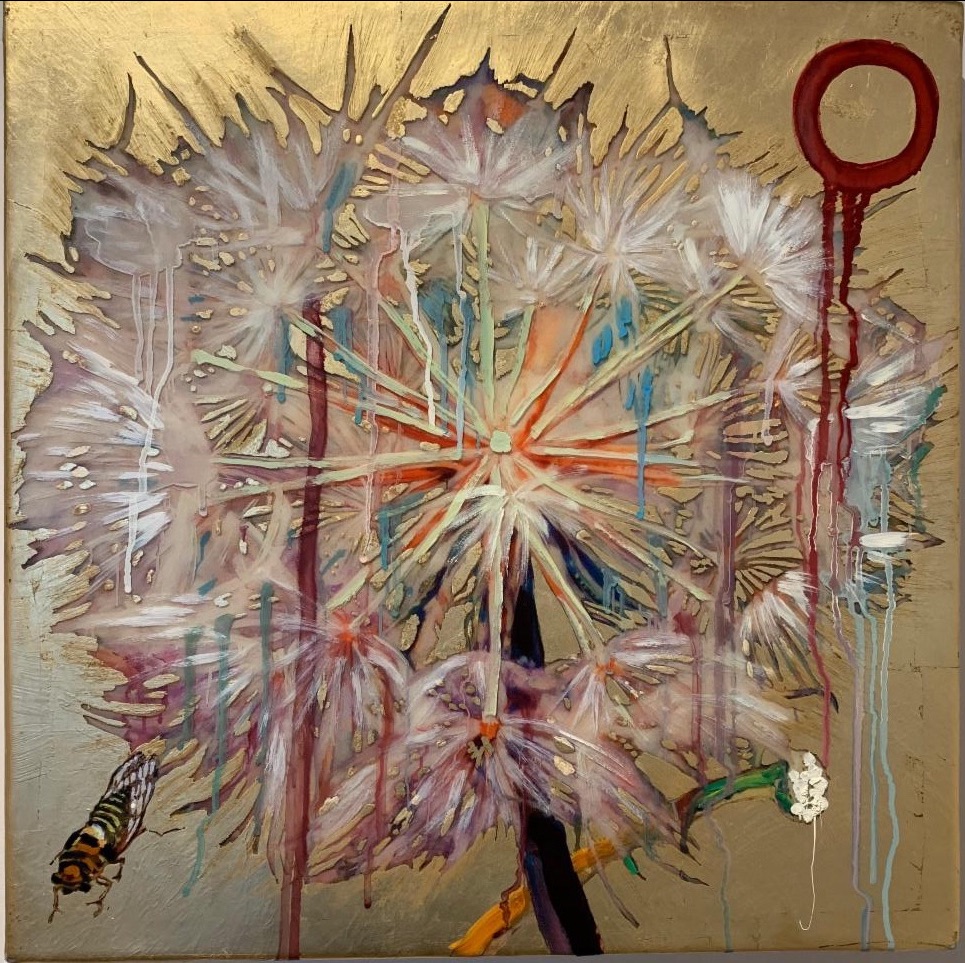
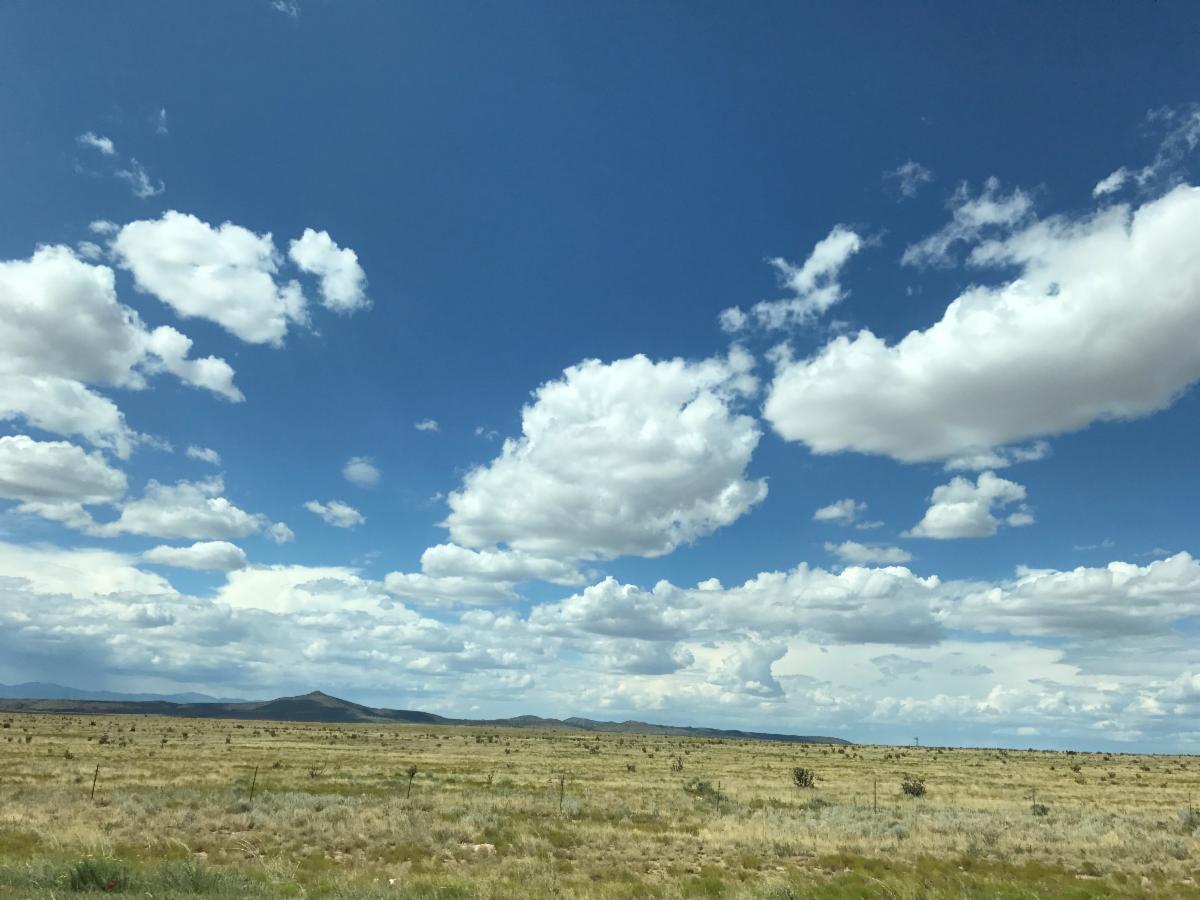


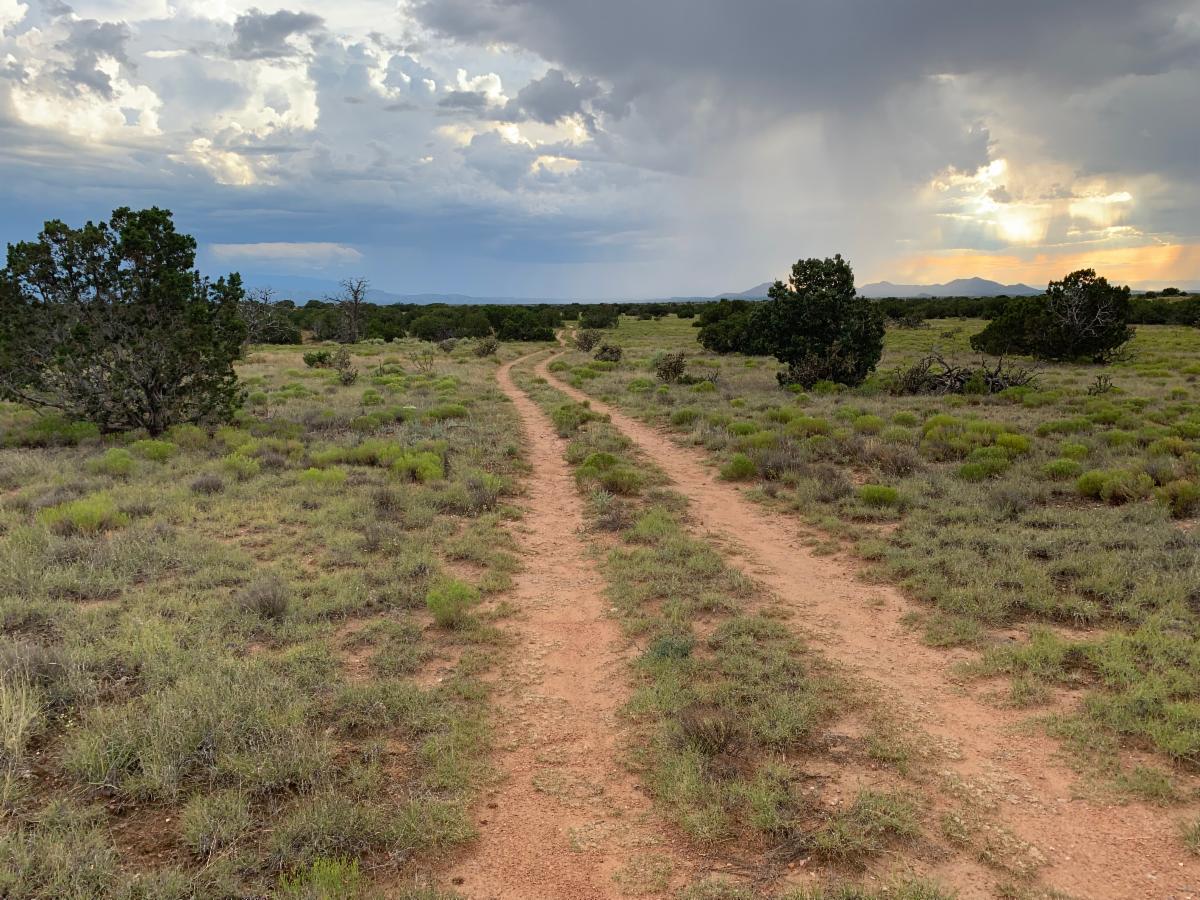
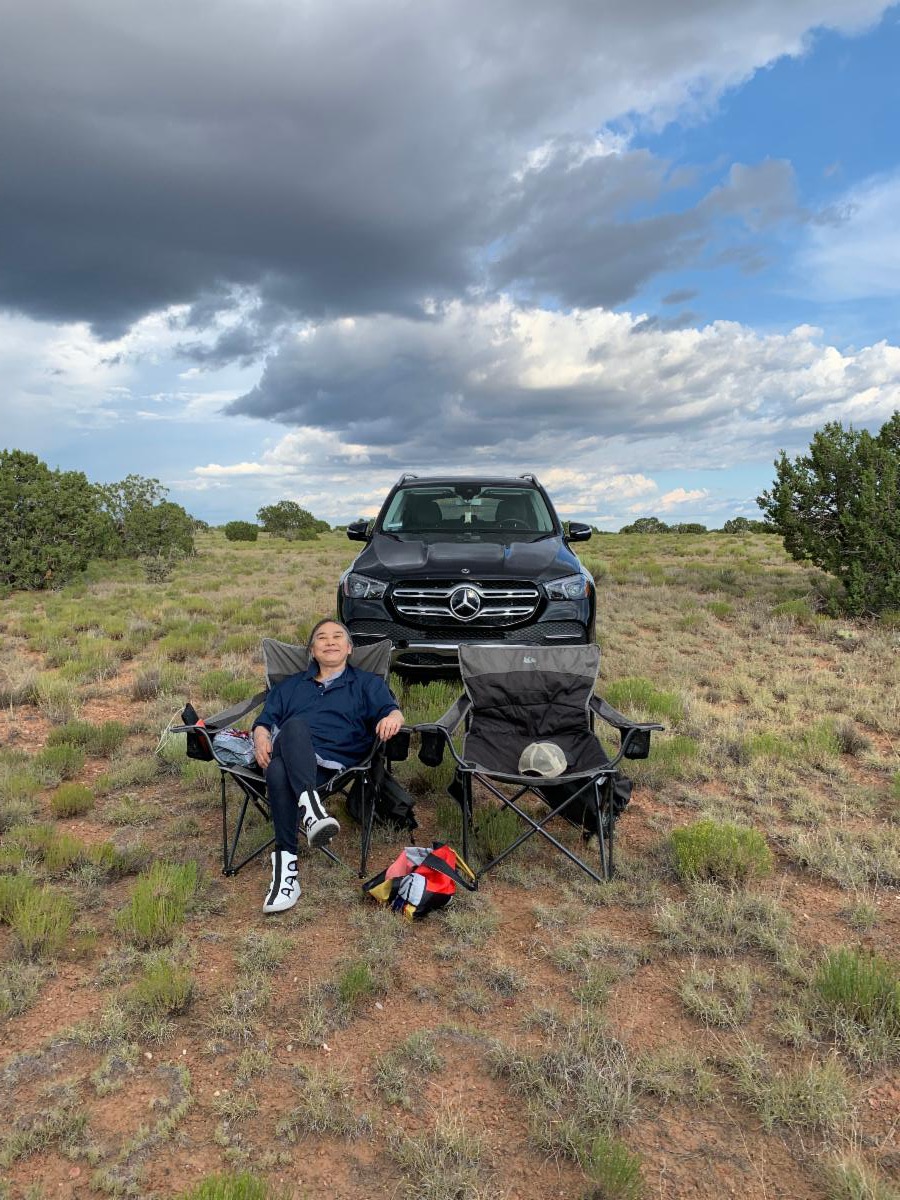
Hung Liu: The Long Way Home
The Grace Museum
Abilene, TX
Sept 7, 2019 - February 22, 2020
Hung Liu: The Long Way Home was a solo exhibition of recent work in a variety of media including mixed media, resin, tapestry, oil and works on paper. The show was organized by the Turner Carroll Gallery in Santa Fe.
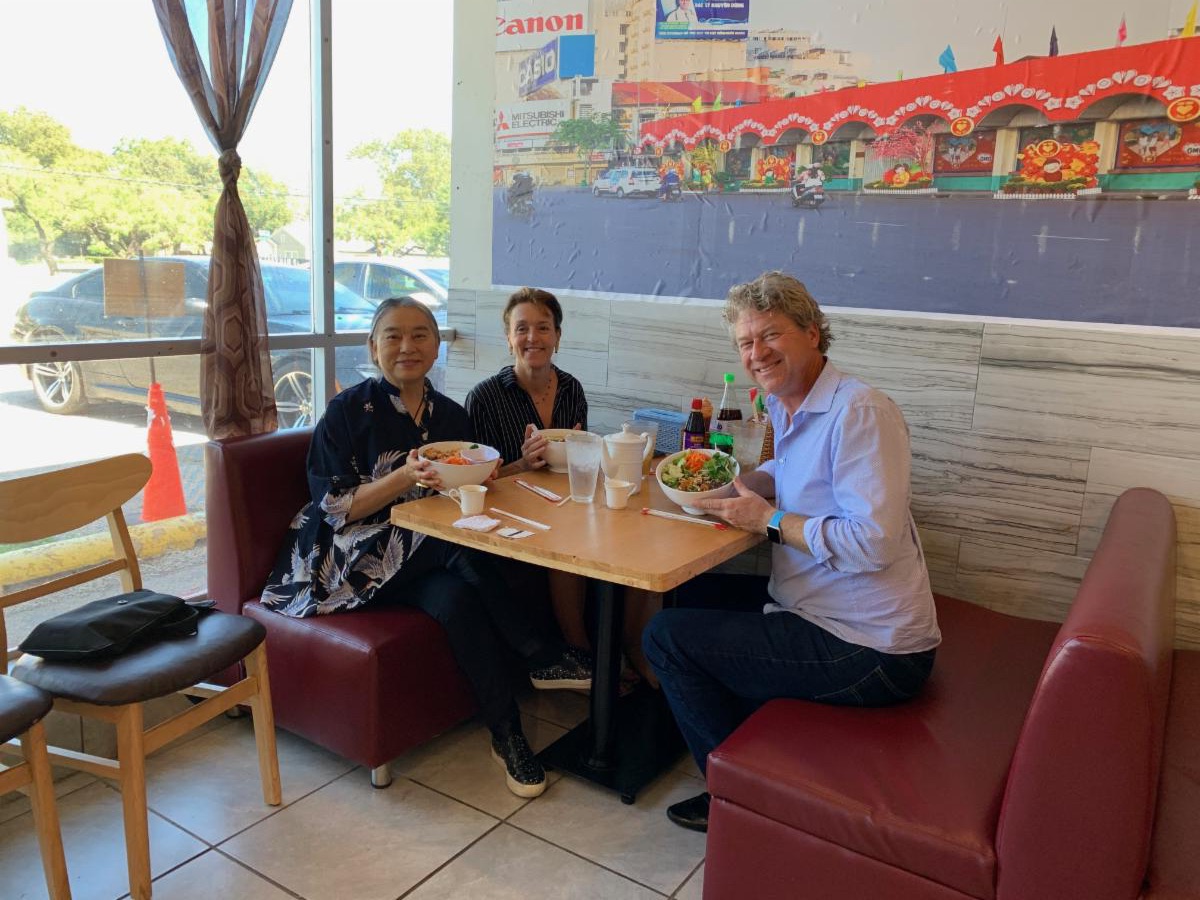
|
Herringer Party
Piedmont, CA
December 6, 2019
When she learned that the Beijing Ministry of Culture cancelled Hung's exhibition with three weeks remaining until the opening, Maryellen Herringer, a dear friend and longtime supporter of artists - who was planning to attend Hung's opening in Beijing - decided to throw a "Cancellation Party" in Hung's honor on the exact date - December 6th - that the opening was scheduled to take place. Phil Tinari, the Director of the Ullens Center for Contemporary Art in Beijing, who organized the now-cancelled show, also came from China to thank everyone who would otherwise have been at Hung's opening. Other luminaries included Neal Benezra, Gary Garrels, and Janet Bishop from SFMOMA, Lori Fogarty of the Oakland Museum of California, Dorothy Moss of the National Portrait Gallery, Era and Don Farnsworth of Magnolia Editions, artist Xi Xiaoze of Stanford, and past president of Mills College Janet Holmgren, among many others. A freely-spoken thank you to Maryellen, whose gathering in her home allowed Hung a most touching "Salon de Refuses."

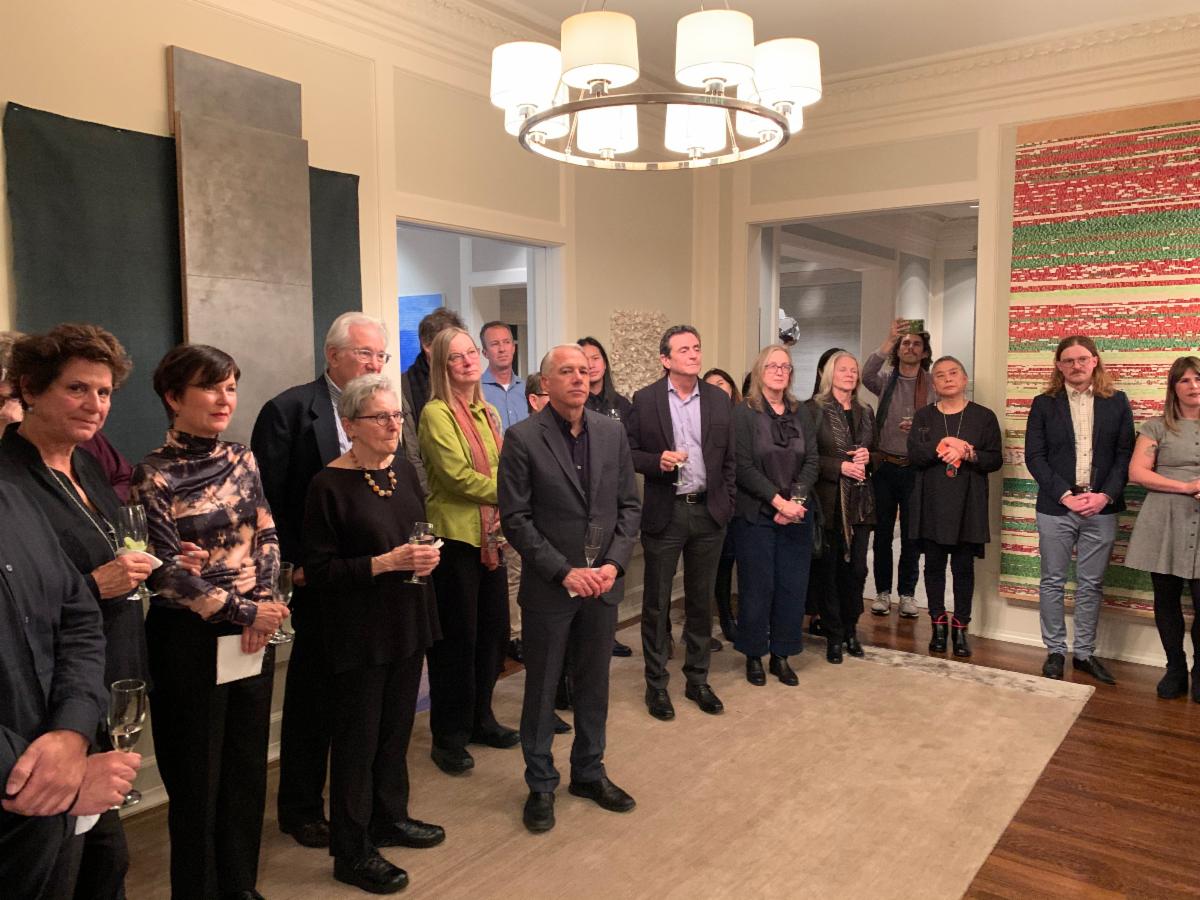
|
|
|
With Dorothy Moss of the National Portrait Galley
|
|
|
|
With Maryellen & Frank Herringer
|
A China Send-Off (& Censorship) Dinner
Rena Bransten Gallery
San Francisco, CA
November 15, 2019
B
efore anybody knew that Hung's Beijing show would be cancelled, the folks at the Rena Bransten Gallery, which has represented Hung since 1991, decided to organize a send-off dinner in Hung's honor. A few days prior, however, it became clear that the Chinese authorities had cancelled Hung's show, so the dinner became an elegant and delicious rally against censorship, with speeches and toasts all 'round!
|
|
|
With Rena Bransten & Cissie Swig
|
|
|
|
Trish Bransten making a toast
|
Thanks to Maryellen & Rena!
|
|
Censorium
As many now know, Hung's scheduled exhibition at the Ullens Center for Contemporary Art in Beijing, "Passerby," was cancelled without explanation at the last moment by the Beijing Ministry of Culture. Our Newsletter #22 was devoted to the show's cancellation and the world-wide press reaction to it.
|
|
Where is Mao?
1987-1988
The famous photograph of Chairman Mao Tse-Tung swimming in the Yangtse River with several members of his entourage in July, 1966, was intended to assure the world that, whatever the chaos of the Cultural Revolution, Mao was still in charge. The image, distributed throughout the global village, was a propaganda coup; it showed the seventy-three year old Chairman to be vigorous, in the mainstream; it showed, indeed, that he was the river, emerging, like the Yangtse itself, out of China's millennial past as its modern face.
For the West, China has always needed a face, and photography has provided it. More often than not since the mid 19th century, its continence has been that of a blank stare, a face being looked at but not really looking back, unable to conceive of whom or what it ought to behold, save the camera itself. Few whose pictures were taken - child prostitutes, street acrobats, executed rebels, beggars, merchants, criminals, women with bound feet - ever saw their images developed; theirs was rather an experience of being staged in front of an elaborate camera, which, in the 19th century, must have looked like a European monkey grinder with a hood. The "faces of China," since the 1860s have likely been those staring at the bizarre theater of the monkey grinder.
Like Big Brother in 1984, Mao's was the expressionless face watching over Chinese society, the father-figure for all citizens. Hung Liu remembers the omnipresence of his likeness on every wall and poster, in every kitchen. Her father was a captain in the Kuomintang, and was captured after the siege of Chang Chun, where Hung was born. She did not see him for forty-six years. Since families often burned their photographs during eras of revolutionary zeal, Hung never knew what her dad looked like. She did know Mao, though, whose image lived in her head at the nexus of a million neurons.
In 1984 Hung came to the US, attending the University of California, San Diego, where she and I met. We moved to Arlington, Texas, in 1986, where I taught at the University of Texas at Arlington. In her living room studio, Hung made art, trying to figure her way between the China in her head and America (or at least Texas) all around her. In 1987 she began a series of ten small canvas pencil drawings, each taken from a print news photo of Chairman Mao meeting various world dignitaries at successive stages of his career. With each drawing, Hung left Mao's face blank - in effect, she erased him. The fact that the artist erased Mao's face from each of her newsworthy drawings is less a political gesture than a psychological one; an ironic way of signifying the ever-present absence of the father, of identifying the visual site of a vague psychic wound in those who, like herself, grew up in Maoist China beneath the omnipotent, benevolent, and ultimately vacant gaze of the "Reddest Red Sun."
Now in the collection of the Denver Art Museum, these works - collectively titled "Where Is Mao?" - were completed during the "New Wave" movement in China, when visual artists began to question the signifiers of authority and the apparatus they stood for. But she drew them in America. Erasing the Chairman's likeness in a society expected to glorify it would then have been - and likely is still now - a dangerous move. Given the recent censorship and cancellation of Hung's scheduled exhibition in Beijing, we thought it might be the right moment to revisit these smart, courageous little drawings.
And anyway, she didn't need to draw Mao's face - she'd seen it a billion times already.
Jeff Kelley
|
|
With Zhu De, 1928
, Pencil on canvas, 12 x 14, 1988
|
|
|
|
Addressing a Peasant Conference,1933
, pencil on canvas, 12 x 14, 1988
|
|
|
|
With Jiang Qing, 1937-38
, pencil on canvas, 12 x 14, 1988
|
|
|
|
Toasts Chiang Kaishek in the hope of Winning a Political Agreement, 1945
, pencil on canvas,
12 x 14, 1988
|
|
|
|
Meeting Khruschev, August, 1958
, pencil on canvas, 12 x 14, 1988
|
|
|
|
With the Indonesian President, Sukarno, 1961,
pencil on canvas, 12 x 14, 1988
|
|
|
|
Keeps Head Above Water, During Swim, Cultural Revolution
, pencil on canvas, 12 x 14, 1988
|
|
|
|
With "Close Comrade-in-Arms" Lin Biao, after 1966, before 1971,
pencil on canvas, 12 x 14, 1988
|
|
|
|
Meeting President Nixon, 1972
, pencil on canvas, 12 x 14, 1988
|
.
............
|
|
|
Hung Liu and her (still) best friend Bing Chen swimming in Beijing in 1966.
|
|
|
Kemper Museum 25th Anniversary
Kemper Museum of Contemporary Art
Kansas City, MS
October 2, 2019
Hung was the guest of honor at the 25th Anniversary Dinner of the Kemper Museum of Contemporary Art, in Kansas City. The Kemper holds one of the largest collections of her work in the United States. (Congratulations from a Niners fan KC!)
|
|
|
Sean O'Harrow, Director of the Kemper Museum
|
Judy Chicago - 80th
Through the Flower Art Space
Belen, NM
July 20, 2019
A visit to Belen, New Mexico, for Judy Chicago's 80th birthday, and her performance of "A Birthday Bouquet for Belen," a smoke and fireworks event. A group from Santa Fe drove south from Albuquerque to the location of Chicago's "Through the Flower" foundation, where she works and welcomes visitors. Downtown Belen now has an art district. Upon meeting, Chicago told Hung, "You've made history." Surprised, Hung though maybe it was the other way around.
|
|
Rena Bransten Gallery
San Francisco, CA
May 23 - July 11, 2020
Gail Severn Gallery
Ketchum, ID
July 9 - August 8, 2020

|
|
| |
The New York Times
"
A prominent arts center in Beijing has canceled a Chinese-American artist's exhibition of works with strong social and historical themes, planned for December, after the local authorities declined to issue the necessary import permits. The cancellation comes amid a growing clampdown on civil society across the country and rising tensions between China and the United States." -Amy Qin
The San Francisco Chronicle
"The show, which was to be on view at the UCCA Center for Contemporary Art in Beijing, was to feature a cross section of Hung's
paintings,
which involve taking common historical photos and turning them into paintings with a cultural context. The images are drawn from both Chinese and American sources, including noted photographer and San Franciscan Dorothea Lange. They tend to feature people on the bottom rung - prostitutes, refugees, laborers and prisoners."
-
Sam Whiting
Artforum
"Among the nine works that the censors took issue with were a self-portrait of the artist carrying a rifle when China's Cultural Revolution ended and a work featuring twelve schoolgirls wearing gas masks, which was based on a historic photograph taken of a school drill during World War II. Liu had originally agreed to remove the artworks from the exhibition, but the authorities ultimately decided to refuse the permits for the remaining pieces."
The Art Newspaper
"Although Chinese authorities have not specified why they have denied an import permit, Liu believes there may be more reasons than the trade war between China and the US. "I don't think the cancellation is based on nationality at all, unless it has something to do with me being an American citizen who grew up in revolutionary China," she says. "My work has always been about human struggle in epic times. There are lots of exhibitions in China, often by foreigners, in which the art is more experimental and in many ways more daring than mine, so I can only guess that, perhaps because of who I am, there is too much history in my work." - Lisa Movius
Art News
"With relations between China and the United States growing strained, the art scenes of both countries have been directly impacted. This week, the UCCA Center for Contemporary Art in Beijing-which is widely regarded as one of the most important contemporary art museums in China-was forced to call off a planned exhibition of work by Hung Liu, who had been due to have a solo show opening in December" - Tessa Solomon
Artnet
"The city of Beijing has canceled a survey of the work of 71-year-old Chinese-American artist Hung Liu, which was scheduled to open at the UCCA Center for Contemporary Art on December 6 and run through March 2020. The news that the Beijing government has declined to approve the show comes as China ramps up its censorship of the arts in recent months." - Taylor Dafoe
Artsy
"
Liu [...]
has shown works in Beijing and Shanghai before, including works that were going to be included in her UCCA show. The artist was born in China and was sent to complete manual labor in the countryside during the Cultural Revolution. She moved to the United States in 1984. She will be the subject of a retrospective at the National Portrait Gallery in Washington, D.C. in 2021." - Christy Kuesel
Los Angeles Times
"In her new work, from 2015 to the present, (Hung) Liu draws upon the photographs of Dorothea Lange (1895-1965). This marks a significant change of subject matter and sourcing for Liu, since Lange is American. It also fundamentally alters the nature of the work." - Leah Ollman
San Francisco Chronicle
"Hung Liu, who's had shows all over the country and spoke at the Minnesota Street Project on Saturday, about 'Women Who Transformed Art in the West,' had been the center of attention the night before at the opening of 'All Over the Map,' a show at the Sanchez Art Center in Pacifica. In these works, curated by Phil Linhares and created with David Salgado at Trillium Press, the artist combines fragments of paintings with photos and historical materials, and embeds them in layers of translucent material, on top of which she paints. It's a complex art form, the results seeming old and new at once." - Leah Garchik
Square Cylinder
"As the public reckons with the necessity of supporting and defending women against male aggression, there is a dizzying prescience in these emotionally gripping images of armed women pushed to the very limits of their endurance." - Nick Stone
Berkeleyside
"It would be hard to imagine an art exhibition more relevant to current events, or one more visually and emotionally stirring, than Daughters of China, the stunning show of monumental oil paintings by East Bay-based artist Hung Liu." -Marcia Tanner
Reporter-Herald
"Liu chose the cookies to represent the gold that drew the immigrants to the West Coast. 'That is also a metaphor of coming to America to seek your fortune, but there is a twist and it's important to know. The twist is the Chinese did not invent fortune cookies,' Kelley said." - Michelle Vendegna
Square Cylinder
"Had Liu stuck to her early training in Socialist Realist and not gotten an American education that permitted and encouraged free expression, the paintings we see here would not, stylistically speaking, have been possible. That the best of them significantly departs from their sources lends double meaning to the titled Promised Land, alluding to both the better life sought by the migrants Lange pictured, and to the stories career Liu achieved after arriving on these shores in 1984 with $20 and a suitcase" - David Roth
San Francisco Chronicle
"The Lange photographs have become so well-known that the people in Liu's paintings seem like old friends, their familiar features recaptured in new portraits and images. It's as though the photographer and her work have been reborn. The Oakland Museum has the Lange archives, and Liu has spent much time there immersed in that work, 'and I talk with her all the time'." - Leah Garchik
San Francisco Chronicle
"It's an artistic risk to take a famous Dorothea Lange picture from the Great Depression and turn it into an oil on canvas. But in the translation, Jung Liu is able to bring unique empathy to Lange's Dust Bowl images, having spent four years working the fields during the Cultural Revolution in People's Republic of China" - Sam Whiting
Huffington Post
"Although some may interpret this work's focus on the American Dust Bowl migration a departure from previous work because the subjects are not Chinese, Liu insists that this new work is not a pivot, but a natural extension of her previous work." - Amy Pleasant
Fresno Bee
"One of the great things about her new Fresno exhibition is the way you can flit back and forth between her earlier days as a student - absorbing the furtive freshness and raw vitality of a rural Beijing - with some of her much more politically pointed works. One of the biggest and most impressive, titled "Modern Time," is based on a banal photograph of a woman daydreaming in a conference room. On the wall behind her are four photographs that used to be found on the walls of schools and public buildings across China: the "four white guys" who helped birth the communist ideology. But Liu offers a subversive twist. She depicts Marx, Engels, Lenin and Stalin in the style of Van Gogh, giving a post-Impressionist hint of snark to the scene." - Donald Munroe
Huffington Post
"A recent visit to the Palm Springs Museum affirms for me that all artists are immigrants. If not in a literal sense then in a figurative sense, they are strangers to the society surrounding them. In the desert resort city, populated by celebrities in steel houses, the local museum is exceptional. At the moment, it has exhibits by both Ai Wei Wei, the Chinese dissident renowned the world over, as well as Hung Liu, a professor of painting from China who has become a citizen of America." - Frank H. Wu
Washington Post
"The centerpiece of that show, Hung Liu's "Daughter of China, Resident Alien," is a pile of some 200,000 fortune cookies atop tracks that evoke the role of Chinese labor in building American railways. In a large painting based on the artist's green card, she takes the name "Cookie, Fortune." Many of Liu's paintings are derived from photos or propaganda-film stills and dissolve realism into abstraction to represent the evaporation of Marxist-Leninist China and her memories of it." - Mark Jenkins
UCSD Visual Arts Department link:
Los Angeles Times
"Her new paintings are portraits of the most humble of flowers - dandelions - and they are spectacular." - Sharon Mizota
Kansas City Star
In "Summoning Ghosts" at the Kemper Museum of Contemporary Art, Chinese-born artist Hung Liu quite literally "summons ghosts," bringing the dead and willfully forgotten into our view through large paintings based on 19th and 20th century photographs taken in China. - Neil Thrun
KQED Radio
Confined in China, Ai Weiwei Directs Alcatraz Exhibit from Afar (Hung Liu interviewed), Mina Kim, September 27, 2014. "Painter Hung Liu is close friends with Ai. Liu grew up during China's Cultural Revolution under Mao Tse-Tung, and like Ai, China's politics and culture infuse her work. She is wary of political art becoming too didactic. 'When you have a strong political agenda, a strong message, you have to be careful if you want to use art form,' the painter says. Liu says she plans to take a serious look at Ai's Alcatraz work, and hopes others will get past his superstar status and do the same.
'Ai Weiwei's super-famous. Some people call him God Ai -
Ai shen
,' Liu says. 'I think it's little too far.'
It's important for people to continue to think critically about Ai's work, Liu says - after all, people tried to make Mao a god, too." - Mina Kim
SF Chronicle
Many contemporary painters struggle to get history into their work without looking pretentious or ideologically motivated. But big events of the late 20th century weighed so heavily on the life of Oakland painter Hung Liu that she might have found it difficult to keep history out of her work.
- Kenneth Baker
Square Cylinder
It's easy to marvel at how Liu's mix of abstraction and realism draw us into the past. Yet virtuosity alone doesn't explain the emotional pull of her painting. So I'll venture a theory: Since Liu works from photos, her painting process is analogous to the photochemical act of "fixing" an image in the darkroom from which pictures seemingly emerge out of nowhere. Liu performs a kind of psychic translation of that act, supplementing it with lived experience and an extraordinary level of empathy. Result: she can paint from photos and literally "summon ghosts."
- David Roth
KQED Radio
Hung Liu is good at summoning ghosts -- from memory and history. She's an Oakland artist born in China, and "Summoning Ghosts" is the title of a new retrospective of her work at the Oakland Museum of California.
- Cy Musiker
Art-Rated
Hung Liu is widely considered one of the most important Chinese artists working in America today.
- Interview by Rachelle Reichert
Art Practical
The spare aesthetic of the exhibition currently on view at the Mills College Art Museum belies the fullness of the Bay Area artist and educator Hung Liu's major concern: history.
- Ellen Tani
Art Practical
In February 1948, the artist Hung Liu was born in Changchun, in the far north of China. Only months later, the city was the site of a major siege by the People's Liberation Army.
- Matthew Harrison Tedford
Contra Costa Times
She's internationally known for her dramatic paintings, which often layer historical images with scenes from her own life or those of everyday people who didn't make it into the history books.
- Angela Hill
San Francisco Chronicle/SFgate
In the early 1970s, Hung Liu, who was being trained in the strict Social Realist style required of Chinese artists at the time, surreptitiously made small landscape paintings that contained no images of Chairman Mao, heroic soldiers or happy peasants. She hid them under her bed to dry.
- Jesse Hamlin
|
|
Publications (Warm off the Press)
|
|
|
|
|
Zoetrope: All Story
Frances Ford Coppola's Literary Magazine
Winter 17/18, Volume 21
|
Hung Liu: Promised Land
Essay by Maria Porges
Rena Bransten Gallery/Hung Liu Studio, 2017
Catalogues available
(Cool off the Press)
|
|
|
Hung Liu: American Exodus
Introduction by Lori Fogarty
Essays by John Yau & Drew Johnson
Interview by Rachelle Reichert
Nancy Hoffman Gallery/Hung Liu Studio, 2016
Catalogues available
|
|
|
|
Hung Liu: Scales of History
Essay by Jeff Kelley
Fresno Art Museum/Hung Liu Studio, 2016
Catalogues available
|
|
|
Hung Liu: Daughter of China, Resident Alien
Essay by David Pagel; Conversation between Peter Selz & Jeff Kelley
American University Museum, Katzen Center, Washington DC/Hung Liu Studio, 2016
Catalogues available
|
|
|
|
Hung Liu: Questions from the Sky
Ed Hardy, Susan Krane
Hahrdymarks Press, 2015
|
Chinese Contemporary Art
Wu Hung
Thames & Hudson
2014
 |
|
Qianshan: Grandfather's Mountain
|
Interview by Rachelle Reichert
Nancy Hoffman Gallery, 2013
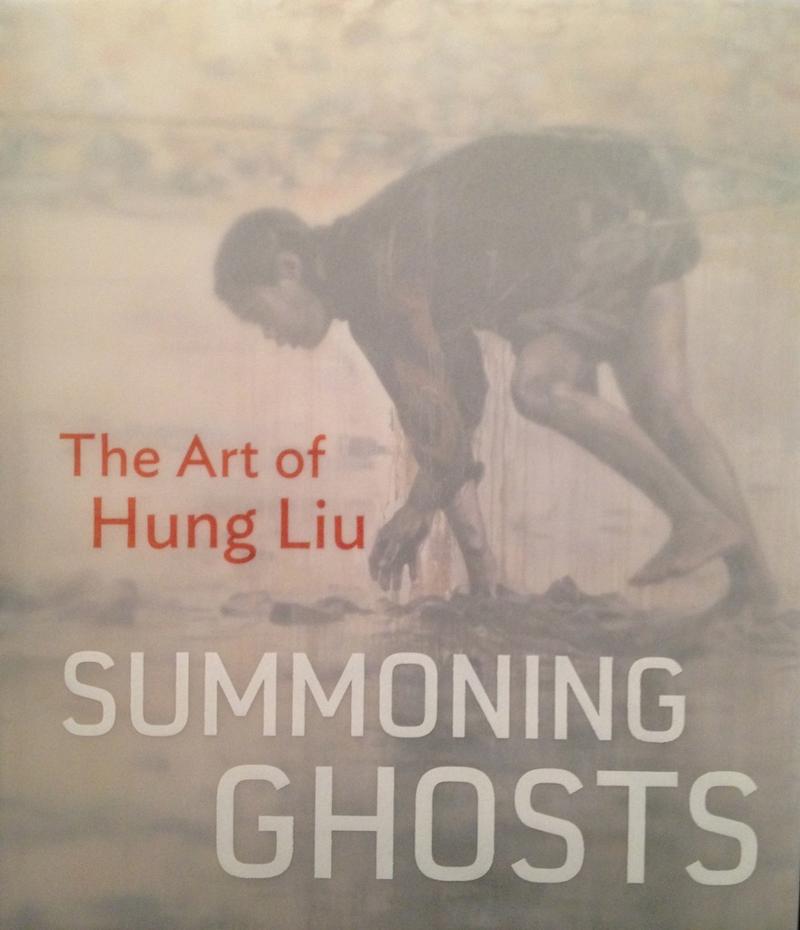 |
|
Summoning Ghosts: The Art of Hung Liu
|
Essays by Wu Hung, Yiyun Li, Rene De Guzman, Karen Smith, Stephanie Hanor, Bill Berkson
216 pages,
Oakland Museum of California & The University of California Press

Hung Liu: Great Granary
Essay & Interview by Wu Hung
Xin Beijing Art Gallery / Timezone 8 Press
Available through Hung Liu Studio
|
Thank You!
Hung Liu Studio |
|
|
|